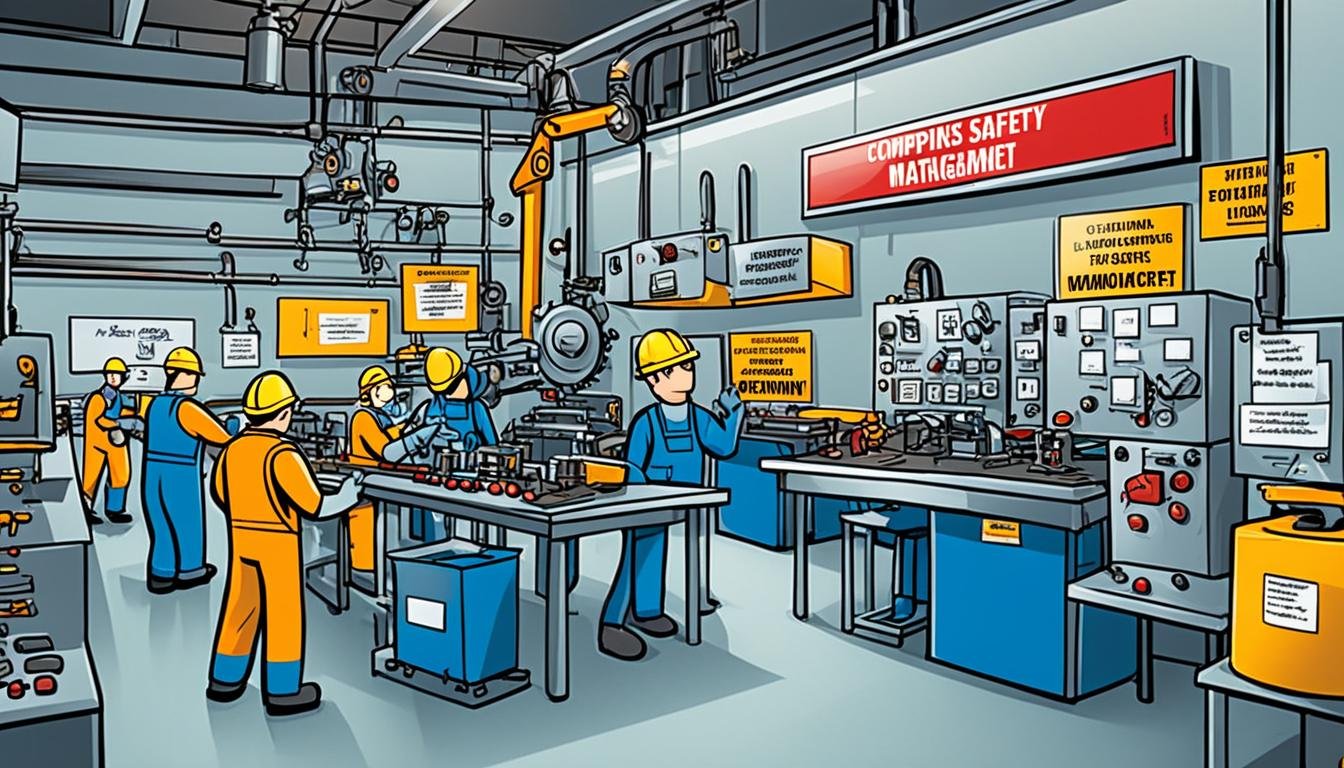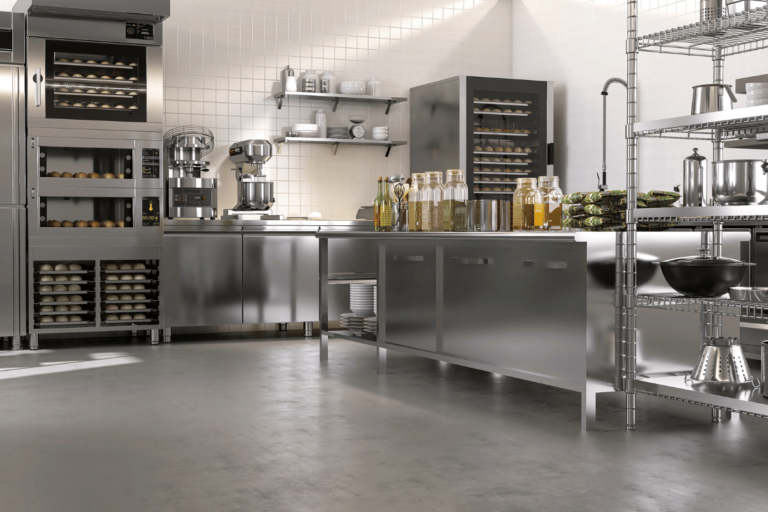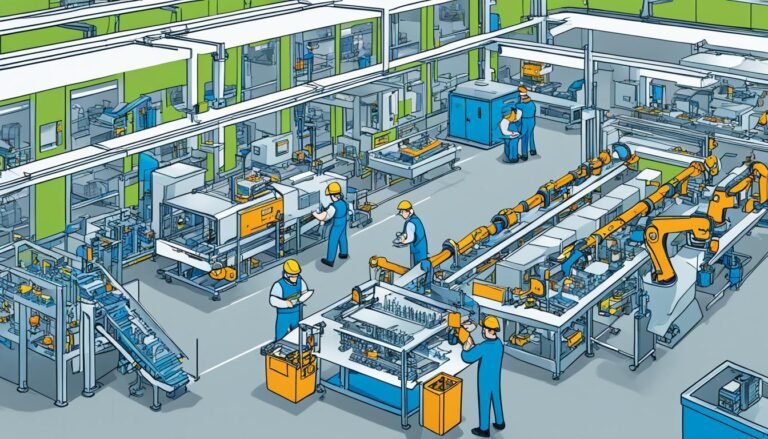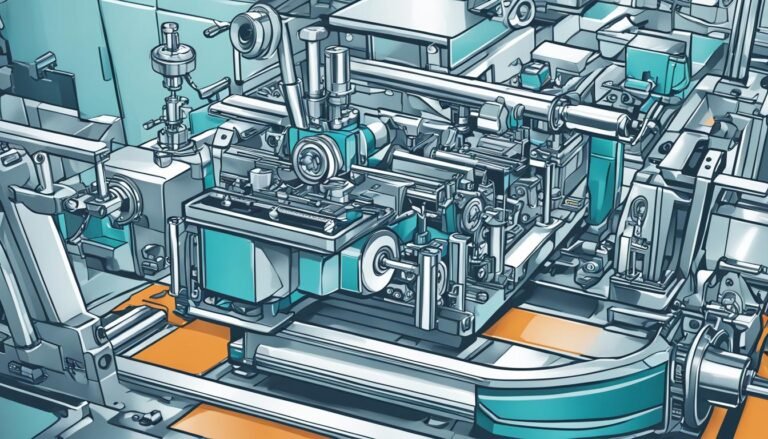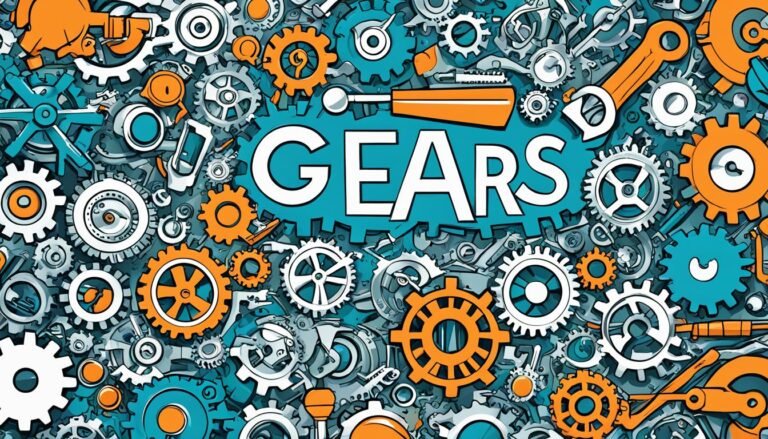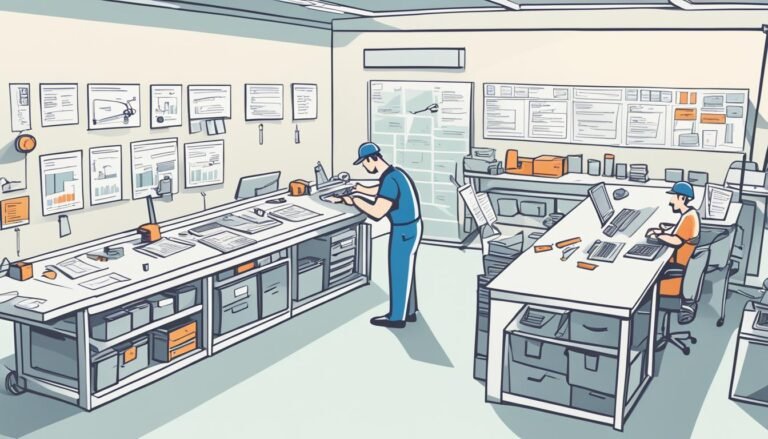Occupational Safety and Health Administration (OSHA) Compliance in Manufacturing
Did you know that falls are a big cause of serious injuries and deaths in manufacturing? This fact shows why following OSHA rules is key for a safe workplace. Companies in manufacturing must follow special guidelines to keep their workers safe.
OSHA sets rules to prevent injuries and deaths at work. These rules include reporting serious incidents quickly. Employers must also share safety records openly.
By following OSHA’s standards, manufacturers can lower risks and meet safety goals. This makes the workplace safer for everyone.
Key Takeaways
- Falls are a leading cause of serious work-related injuries and fatalities in manufacturing.
- Employers must report work-related fatalities within 8 hours and other severe incidents within 24 hours.
- OSHA Form 300A summary must be posted from February 1 for three months.
- Adherence to OSHA regulations ensures improved workplace health and safety.
- Industry-specific guidelines help manufacturers maintain compliance and reduce risks.
The Importance of OSHA Compliance in Manufacturing
In the manufacturing world, following OSHA rules is key. These rules help prevent accidents and keep workers safe. They make sure machines and processes are safe to work with.
Why OSHA is Crucial for Workplace Safety
OSHA is important for keeping the workplace safe. It sets rules to stop accidents and illnesses. Following these rules makes work safer and more efficient.
Training on dangerous jobs and how to use equipment right is crucial. It helps lower the chance of accidents.
Impact of Non-compliance on Manufacturing Operations
Not following OSHA rules can hurt a manufacturing business a lot. It can lead to big fines, legal trouble, and work stoppages. These problems can really affect a company’s success.
It’s important to keep up with OSHA changes and have regular checks. This keeps safety first in mind.
Key OSHA Standards for the Manufacturing Industry
Following OSHA standards is key to keeping workers in manufacturing safe. These rules help lower risks from different manufacturing tasks. Companies must follow these standards to keep their workers safe and work efficiently.
Machine Guarding
Machine Guarding (29 CFR 1910.212) is a main OSHA rule. It requires guards on machines to stop injuries from moving parts. This is very important because machines are a big part of manufacturing.
Hazard Communication
The Hazard Communication standard (29 CFR 1910.1200) is also very important. It talks about labeling chemicals and giving safety data sheets for dangerous ones. This helps workers know about and handle chemicals safely, lowering the chance of accidents.
Respiratory Protection
The Respiratory Protection standard (29 CFR 1910.134) is key for worker safety. It says manufacturers must give workers the right masks and make sure they work well. This includes training and keeping the masks in good shape to protect against harmful air.
Lockout/Tagout Procedures
Lockout/Tagout (LOTO) procedures (29 CFR 1910.147) stop machines from starting by accident during maintenance. These steps are important to make sure machines are turned off, locked, and marked. This helps avoid serious injuries when fixing things.
Here’s a closer look at what OSHA focuses on in different industries:
| Industry | Focus Area | Key Compliance Resources |
|---|---|---|
| Battery Manufacturing | Lead Exposure | Safety and Health Topics Pages, eTools |
| Food Processing | Ammonia Refrigeration | Industry-specific guidelines, ergonomic solutions |
| Plastics Industry | Machine Guarding | Ergonomic solutions, Safety and Health Topics Pages |
| Chemical Manufacturing | Chemical Reactivity Hazards | Specialized safety resources, industry collaborations |
OSHA works with groups like the Sealant Waterproofing and Restoration Institute and the Institute of Scrap Recycling Industries. These partnerships aim to give special help, focusing on things like keeping manufacturing equipment safe and controlling energy well. By looking at big issues like how chemicals are used and keeping the air safe, OSHA wants to make work safer and healthier in many industries.
Risk Assessment and Hazard Prevention
Keeping the workplace safe and following the law is key. This part will look at how to spot hazards and do risk assessments. It will also cover how to prevent problems to meet OSHA standards.
Identifying Common Workplace Hazards
Manufacturers must watch out for risks at work. These can be things like getting caught in machines, being exposed to chemicals, or having a job that strains your body. Not seeing these dangers can lead to injuries and illnesses. So, it’s important to check the workplace often.
Checking different sources helps spot risks. This includes looking at manuals, reports, injury records, and workers’ comp info. Regular checks can find new dangers from changes in work areas, processes, or tools. Health risks, like chemical or biological dangers, can be harder to spot than physical ones.
Conducting Effective Risk Assessments
Having a good plan for risk assessment is key. By looking at the dangers and how big they are, employers can take steps to prevent them. OSHA wants detailed records of these steps to make sure everyone is safe and following the rules.
Looking into incidents is also important. It helps find dangers that could cause more problems and figure out why they happened. With training for workers and new safety rules, these steps help prevent future issues.
In short, finding and fixing workplace dangers is important for following the law and keeping everyone safe. By focusing on managing risks, manufacturers can protect their workers and keep their business running well.
The Role of Personal Protective Equipment (PPE) in Manufacturing
PPE is key to keeping workers safe in manufacturing. OSHA sets strict rules to protect employees from dangers at work. Knowing the main types and how to keep them up can really help use PPE right, keeping workers safe.
Types of PPE Needed in Manufacturing
In manufacturing, different PPE is needed for various parts of the body. Important items include:
- Eye and Face Protection: Safety goggles and face shields to stop chemicals, particles, or sparks from getting in.
- Head Protection: Hard hats to protect from falling things and bumps.
- Foot Protection: Safety boots to prevent injuries from heavy or sharp objects.
- Hand and Arm Protection: Gloves to protect against burns, cuts, and harmful substances.
- Body Protection: Aprons and suits to protect against corrosive chemicals and extreme heat.
- Hearing Protection: Earplugs and earmuffs to stop hearing loss in loud places.
Ensuring Proper Use and Maintenance of PPE
Using PPE right means giving the right gear and keeping it in good shape. Employers must follow OSHA rules. This means workers must:
- Training: OSHA says workers need full training on how to use PPE correctly.
- Hazard Assessment: Employers must check for dangers and pick the right gear, as OSHA rules.
- Maintenance and Inspection: Regular checks and replacing gear when needed are key to keeping it safe.
- Written Certification: Keeping records of hazard checks and gear use is important, as OSHA says.
| OSHA Regulation | Description |
|---|---|
| 1910.132(a) | Rules for using protective gear in manufacturing. |
| 1910.132(f)(1) | Training rules for using PPE at work. |
| 1910.132(h)(5) | Employers must replace worn-out or damaged PPE. |
Pay close attention to using PPE right, keeping it in good shape, and following OSHA rules. This helps lower health risks for manufacturing workers. By checking and updating PPE plans, employers can make a safer work place for all.
Employee Training and Awareness Programs
Keeping a manufacturing place safe and productive depends a lot on good employee training and awareness programs. These programs help improve safety and skills in the industry. They make sure every worker knows how to deal with dangers at work.
OSHA Training Requirements
All manufacturing workers must get OSHA safety training. This covers important topics like how to spot hazards, control them, and report incidents. Workers need training in languages and reading levels they can understand.
Implementing Continuous Training Programs
Keeping up with safety training is key in manufacturing. Training should happen often, through different ways like group learning and on-the-job training. Managers also need special training to help keep the workplace safe.
| Training Category | OSHA Standard | Details |
|---|---|---|
| Hazard Communication | 29 CFR 1910.1200 | Training on handling and communicating information about hazardous chemicals in the workplace. |
| Emergency Action Plan | 29 CFR 1910.38 | Employers must develop and implement an emergency action plan. |
| Machine Guarding | 29 CFR 1910 Subpart O | Training for operating and maintaining machinery safely. |
| Lockout/Tagout | OSHA Standard 1910.147 | Procedures to control hazardous energy during service and maintenance of machines. |
Following these training rules helps companies meet safety laws and build a skilled, alert workforce. This makes safety the top priority.
Machine Guarding and Safe Equipment Use
Machine guarding is key in the manufacturing world to stop injuries and keep equipment safe. It uses different materials and methods based on the situation and rules.
Importance of Machine Guarding
Good machine guarding cuts down the risk of serious injuries like amputations and cuts. Every year, about 18,000 people get hurt and over 800 die from not using or having bad guards on machines. With the right guards, you can avoid touching moving parts, keep the machine running smoothly, and not create new dangers.
- Metal: It’s the top choice for its strength and lasting power, used everywhere.
- Plastic: It’s better for seeing things clearly but not as strong as metal.
- Wood: Used in woodworking and building, but not often because it can burn and doesn’t last long.
There are many ways to guard machines, like fixed and interlocked guards, and presence-sensing devices and two-hand controls. Fixed guards stay there all the time and keep things safe. Interlocked guards make a machine stop when opened. Adjustable guards change size with the stock, and presence-sensing devices use light to keep hands safe.
Checklist for Safe Equipment Use
To make a good machine guarding plan, follow these steps:
- Look at every machine, new or old, for dangers.
- Make sure guards are tight and stop hands from touching moving parts.
- Put machines in places where people can’t get too close.
- Teach workers how to use and why machine guards are important.
- Make sure guards follow OSHA rules to avoid big fines and legal trouble.
A good machine guard should:
| Criteria | Description |
|---|---|
| Prevent Contact | Guards must stop workers from touching dangerous parts. |
| Secure Attachment | Guards need to be attached well and not taken off or changed easily. |
| Durability | Guards should be made of strong materials that last in the work area. |
| No new Hazards | Guards can’t make new risks or make the machine harder to use. |
| No Interference | Guards should let the machine work without getting in the way. |
| Safe Lubrication | Guards should let you oil parts easily without taking them off. |
Machine guarding is more than just a rule. It’s a way to keep everyone in manufacturing safe and healthy.
Effective Chemical Handling and Storage
Keeping chemicals safe in the manufacturing world means following OSHA rules closely. Employers must make sure workers are protected from dangers when they handle and store chemicals.
OSHA Standards for Chemical Safety
OSHA sets rules to keep workers safe with chemicals:
- 1910.1200(b)(1): Chemical makers or importers must sort out the dangers of the chemicals they make or bring in.
- 1910.1200(b)(2): Workers need to know about the chemicals they work with every day.
- 1910.1200(b)(4): Rules apply to handling sealed containers, like in shipping and storing goods.
- 1910.1200(b)(5): Some chemicals, like pesticides and food items, don’t need special labels.
- 1910.1200(b)(6): Things like hazardous waste, tobacco, and solid drugs don’t have to follow the rules for handling chemicals.
To meet these rules, employers must train workers and keep safety data sheets for dangerous chemicals. They also need to make sure labels on chemical containers are not damaged.
Best Practices for Chemical Storage
Storing chemicals safely is key to avoiding accidents and following OSHA rules. Important steps include:
- Identification: Make sure to label all dangerous chemicals correctly.
- Segregation: Keep chemicals in safe spots, away from things they shouldn’t mix with.
- Organization: Keep chemicals in order to avoid spills.
- Monitoring: Check storage areas often to keep things safe.
Employers should also keep training workers on how to handle chemicals safely, what to do in an emergency, and how to use protective gear. Following these rules and best practices can greatly lower the chance of accidents with chemicals in the workplace.
Conclusion
Following OSHA rules in manufacturing is crucial for worker safety and keeping things running smoothly. OSHA was created after many workplace accidents. Now, it helps set important safety rules.
These rules have made work safer, cutting down on deaths and injuries. This shows how vital OSHA is for protecting workers.
Following OSHA rules, like keeping machines safe and telling workers about dangers, is key to preventing risks. Using the right protective gear and training workers helps keep the workplace safe.
Training workers often makes sure they know how to keep things safe. This keeps the workplace safe for everyone.
Not following OSHA rules can cost a lot, especially in terms of worker injuries and deaths. But, having fewer accidents saves money, as shown by groups like the National Safety Council. New tools like Quickbase help make following OSHA rules easier and safer.
Sticking to OSHA rules in manufacturing protects workers and helps the business run better. By using these rules and new safety tools, companies can make a safe work culture. This leads to success and reliability over time.
Source Links
- Employer Responsibilities | Occupational Safety and Health Administration
- Compliance Assistance Quick Start – General Industry
- The Importance of OSHA Compliance – DoctorsManagement
- The Importance of OSHA Compliance to Your Business – U.S.SAWS
- Industry-Specific Resources | Occupational Safety and Health Administration
- WHAT ARE OSHA STANDARDS FOR THE MANUFACTURING INDUSTRY?
- Division D: Manufacturing | Occupational Safety and Health Administration
- Safety Management – Hazard Identification and Assessment
- Occupational Safety and Health Administration (OSHA)
- OSHA Compliance: Ensuring Workplace Safety | Capstone
- 1910.132 – General requirements. | Occupational Safety and Health Administration
- Personal Protective Equipment (PPE) Assessment
- Safety Management – Education and Training
- Sample Programs | Occupational Safety and Health Administration
- OSHA Requirements: Machine Guarding – Grainger KnowHow
- OSHA Requirements for Machine Guarding & Compliance
- 1910.1200 – Hazard Communication. | Occupational Safety and Health Administration
- Chemical Safety in the Workplace: Best Practices and Regulations | Noah Chemicals
- Hazard Communication – Overview | Occupational Safety and Health Administration
- Manufacturing Safety & OSHA: Compliance or Welfare? – Optimation
- How Manufacturers Can Streamline OSHA Adherence

